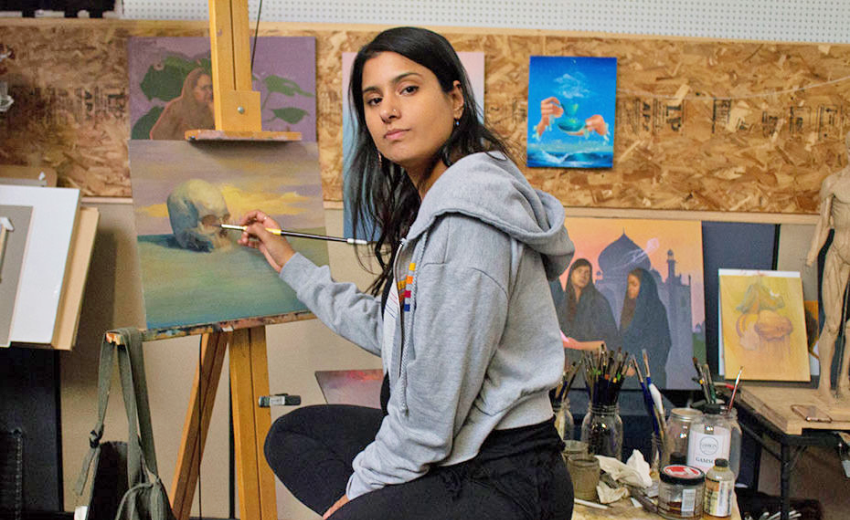Colorful, striking, and thought-provoking, Rupy Kaloti’s paintings (@eyebeonit) and dream-like portraits captivate one’s attention. Her surrealist work nevertheless manages to uniquely capture Punjabi folk stories and her heritage as a Sikh-American, something I find compelling and intriguing.
A painter and draftsman from the Bay Area, California, Rupy is an award-winning artist and the recipient of the 2018 Grand Central Atelier Summer Scholarship and 2017 Sadie Valeri and David Kassan scholarships. She works out of her studio in San Jose.
Rupy’s work will be featured in “Expressions of Divinity,” a one-of-a-kind perspective of Sikh art and artists organized by the Sikh Foundation and Ik Onkar Bridges.
I had the opportunity to talk with Rupy about her Sikh influences, artistic perspective, and experiences as a Sikh artist in the field.
To see Ruby's paintings visit her website.
Q: Are your portraits based on your family or people you’ve met?
A: Some are paid models. Most of the people I paint are my friends and family. They always seem flattered when I ask them to pose for me. Some of them are really into it and others I have to coax. I enjoy painting people I know because I can represent their personalities.
Q: What is your favorite piece that you’ve created and can you tell us why?
A: I’m really enjoying working on “Ardaas.” When the Triton Museum approached me about making a few paintings about my heritage, I came up with the idea. It’s a painting of three women standing in prayer. The main focus of the painting is the girl in the center and she represents me. She is basically daydreaming during prayer.
My parents are religious so I had to attend Sunday School at the Gurdwara every week. Whenever we’d study Sikh scriptures, my imagination would spark. The painting is very much about that experience.
The other two paintings in the show are of my mom and dad. Our family was one of the first Punjabi Sikh families to migrate over to San Jose in the 80’s. Because of that I didn’t grow up around a lot of Punjabi people who weren’t family. I basically learned about Sikhism through my parents. They were my main teachers.
I linked my paintings back to how they taught me about Sikhism. One of the main teachings of Sikhism is that all human beings can have direct access to God with no need of rituals or priests. I thought hard of how my parents connected with God.
My mom connects with God through nature and her home. Both of which I’ve painted alongside her. I think she finds more happiness in nature which is why I made the plants larger than anything else in the painting.
My dad connects with God through prayer. The first thing he does when he gets off from work is turn on the radio to listen to the local broadcast from the Gurdwara. I painted a city coming out of his head because there’s a richness to the stories that he tells. The city represents his connection to the spiritual realm.
Q: When did you first know that you wanted to pursue art as a career?
A: I knew around the age of 17 when I enrolled in an advanced art class in high school. I always had a vivid imagination and liked to visualize scenes and stories. Pursuing it as a career came much later, at the age of 23. I started considering it seriously after I grew unhappy at a corporate job. I worked as an Industrial Designer and Graphic Designer. I think I started feeling void of emotions and life started to lose its magic. I came back to art after that.
Q: Who or what are some of your greatest artistic influences?
A: I’m inspired by the work of Jean-Léon Gérôme, Yoshida Hiroshi, and John Singer Sargent to name a few. I love the draftsmanship of all of these painters. Gérôme’s paintings of the Middle East remind me of India. They are insanely detailed and beautiful. I think Hiroshi’s color choices are beautiful as well. He was Japanese but went to India to paint landscapes and some of those works are incredible. I enjoy Sargent because of his use of cool and warm tones in portraiture. I enjoy reading about his painting process.
I absolutely love graffiti and street art as well. I draw influence from the world around me: Sikh architecture, Sikh history, and the bright and colorful West Coast graffiti I see in the Bay Area.
Q: What are some stories from Sikh history that have inspired your art?
A: As a first-generation American, I am proud of my strong Sikh heritage.
I was raised on stories of Punjabi folklore and spent summers on the farm in my native Punjab. I remember hearing the story of Guru Nanak stopping a rolling rock with one hand, told by my grandfather. This belief in magic inspired an interest in surrealism, a genre I feel has always been a part of me and one I aim to embody in my work.
My dad loves telling the stories of Guru Nanak and his travels. I feel like a lot of these stories are ingrained in me. I enjoy reading about the Sikh Empire and about India when it was under Mughal rule.
Q: Can you tell us what a typical day is like in the studio?
A: I usually start off by getting coffee down the street. I get all my materials ready and organize my oil paints on my palette. I do a daily prayer and burn sage before I paint. It helps me come into a place of gratitude and makes painting even more enjoyable.
Q: What advice do you have for others who wish to pursue the fine arts?
A: Practice every day. And then find like-minded people who understand what you’re going through and who share common goals. Pursuing a creative career is definitely challenging. Making sure that you have a good support system is vital to creative growth.
Q: Are there any challenges you face as one of a few Sikh artists in the field?
A: I thought it would be challenging to break into art but the Sikh community has been very supportive from the start. I get amazing feedback when I participate in shows. I didn’t think my art would connect with the older generation but they love it.
Q: What impact do you hope your art will have 10 years from now, both in the Sikh community and beyond?
A: It’s hard for me to imagine myself 10 years from now. I’m really just recording my experiences as they come and putting them into paintings. I hope that people have an emotional connection with it. That’s something I always try to capture.
Q: Is there anything else you wish to share with the Sikh Foundation community?
A: Yes, come see my painting in person from August 31-November 3, 2019 at the Triton Museum in Santa Clara!
You can also follow/ view my progress on Instagram. My username is @eyebeonit.
Aug 31- Nov. 3 2019
1505 Warburton Avenue
Santa Clara CA 95050-USA
Tuesday-Sunday 11am-5pm
Save the Dates: Free Admission
Aug 31st Opening Celebration with Family Art Day & Fair 12-4pm.
Sept 13th Friday Artist Reception 6-8pm.
Sept 25th Brown Bag Lunch~ Sonia Dhami 12-12.45 pm.
Oct. 9th Brown Bag Lunch with Rupy C. Tut 12 -12.45 pm

